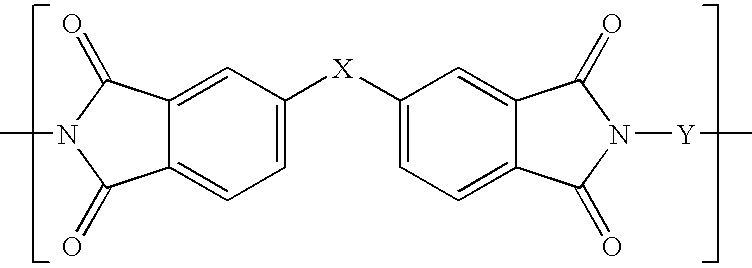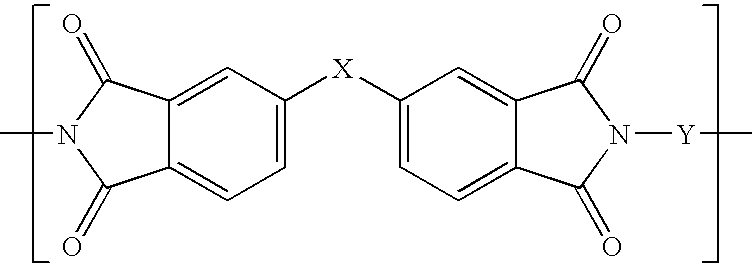Compositions comprising polyimide and hydrophobic epoxy and phenolic resins, and methods relating thereto
a technology of hydrophobic epoxy and phenolic resin, which is applied in the field of compositions having a polyimide component, a hydrophobic epoxy component, a hydrophobic phenolic resin and an organic solvent, can solve the problems of silver plating being expensive, resistance properties can tend to drift or otherwise become problematic, and the effect of increasing the cost of silver plating
- Summary
- Abstract
- Description
- Claims
- Application Information
AI Technical Summary
Problems solved by technology
Method used
Image
Examples
example 1
[0059]A polyimide was prepared by conversion of a polyamic acid to polyimide with chemical imidization. To a dry three neck round bottom flask equipped with nitrogen inlet, mechanical stirrer and condenser was added 800.23 grams of anhydrous DMAC, 65.98 grams of 3,3′-bis-(trifluoromethyl)benzidine (TFMB), 18.86 grams 2,2′-bis(3-amino-4-hydroxyphenyl)hexafluoropropane (6F-AP) and 0.764 grams of phthalic anhydride.
[0060]To this stirred solution was added over one hour 113.26 grams of 2,2′-bis-3,4-dicarboxyphenyl)hexafluoropropane dianhydride (6-FDA). The solution of polyamic acid reached a temperature of 32° C. and was stirred without heating for 16 hrs. 67.68 grams of acetic anhydride were added followed by 61.73 grams of 3-picoline and the stirred solution was heated to 80° C. for 1 hour.
[0061]The solution was cooled to room temperature, and the solution added to an excess of methanol in a blender to precipitate the product polyimide. The solid was collected by filtration and was wa...
example 2
[0063]EXAMPLE 2 illustrates the use of a high Tg crosslinkable polyimide used in a PTF resistor composition that contains hydrophobic epoxy and phenolic resins. A PTF resistor paste composition was prepared using the polyimide solution of EXAMPLE 1. This was performed by adding, to the polyimide solution, the additional components listed below, including but not limited to, a hydrophobic epoxy resin, a hydrophobic phenolic resin and electrically conductive materials. The PTF resistor paste composition was prepared by mixing the following ingredients in an ambient environment with stirring to give a crude paste mixture.
Ingredient% by weightTiC nano powder 130 nm11.69R1396 carbon black paste 110.73Boron nitride powder15.47Silicone carbide powder4.57Polyimide medium 157.16Benzotriazole0.282-undecanone0.9
[0064]The paste composition was 50.0 percent by weight solids. The PTF resistor paste was 3-roll milled with a 1 mil gap with 3 passes each set at 0, 100 and 200 psi pressure and 6 pass...
example 3
[0065]EXAMPLE 3 illustrates the use of a high Tg crosslinkable polyimide used in a PTF resistor composition that contains hydrophobic epoxy and phenolic resins. A PTF resistor paste composition was prepared using the polyimide solution of EXAMPLE 1. This was performed by adding, to the polyimide solution, the additional components listed below, including but not limited to, a hydrophobic epoxy resin, a hydrophobic phenolic resin and electrically conductive materials. The PTF resistor paste composition was prepared by mixing the following ingredients in an ambient environment with stirring to give a crude paste mixture.
Ingredient% by weightTiC nano powder 30 nm11.69R1396 carbon black paste 110.68Boron nitride powder15.46Silicone carbide powder4.62Polyimide medium 157.16Benzotriazole0.282-undecanone0.11
The paste composition was 50.0 percent by weight solids. The paste was screen printed as Example 2.
PUM
| Property | Measurement | Unit |
|---|---|---|
| boiling point | aaaaa | aaaaa |
| viscosity | aaaaa | aaaaa |
| mole ratio | aaaaa | aaaaa |
Abstract
Description
Claims
Application Information
 Login to View More
Login to View More - R&D
- Intellectual Property
- Life Sciences
- Materials
- Tech Scout
- Unparalleled Data Quality
- Higher Quality Content
- 60% Fewer Hallucinations
Browse by: Latest US Patents, China's latest patents, Technical Efficacy Thesaurus, Application Domain, Technology Topic, Popular Technical Reports.
© 2025 PatSnap. All rights reserved.Legal|Privacy policy|Modern Slavery Act Transparency Statement|Sitemap|About US| Contact US: help@patsnap.com



